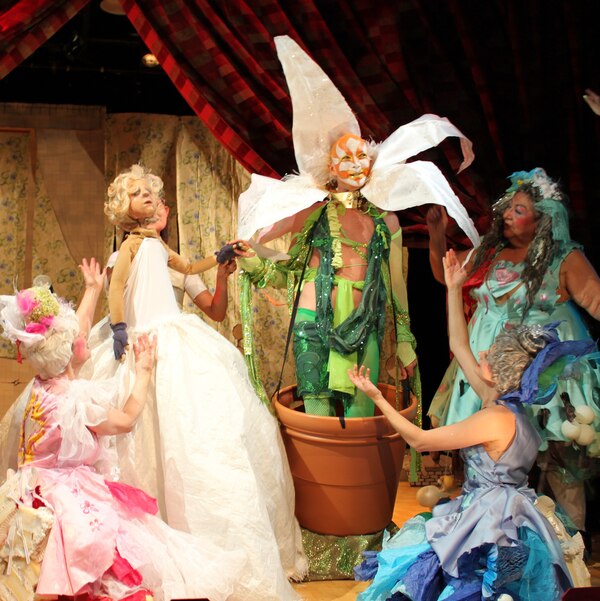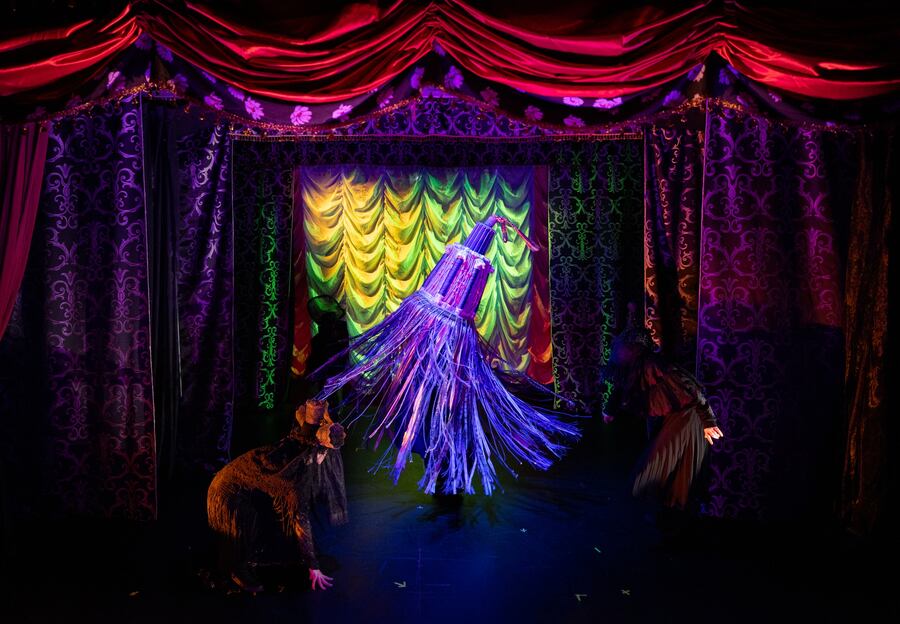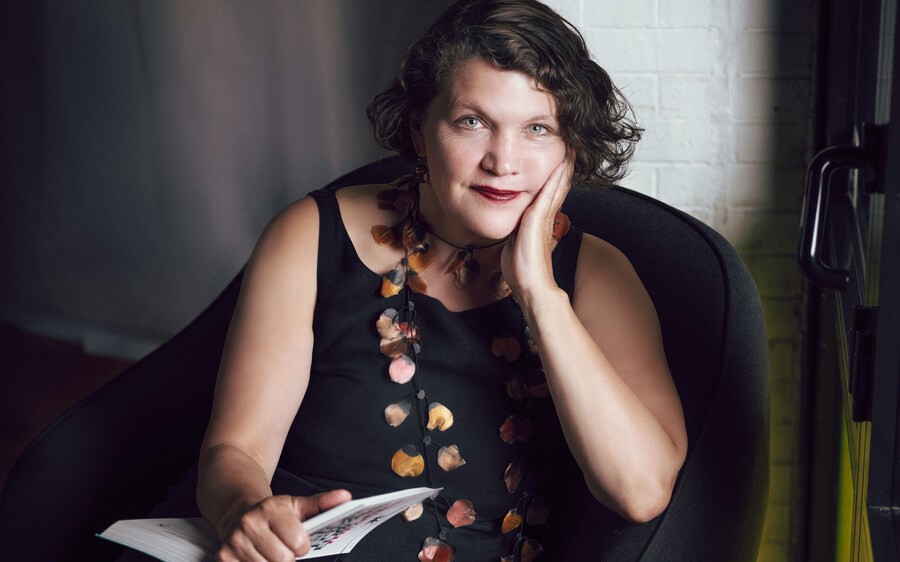It’s been one of the defining features of New York City arts at least since the 1960s: the vibrant, influential downtown theatre scene that gave the world the Living Theatre and the Wooster Group, Sam Shepard and Ping Chong. HERE Arts Center, founded in the ’90s, has been both a home for and a major player on that downtown scene, with a particular focus on interdisciplinary performances involving music, video, puppetry, and visual art.
Artistic director Kristin Marting has been at HERE since the beginning, producing or presenting such hits as Basil Twist’s Symphonie Fantastique and Arias With a Twist, Taylor Mac’s The Lily’s Revenge, and a little show you might have heard of called The Vagina Monologues. Now, after a little over 30 years at the helm, Marting is stepping down to make way for new leadership and to rekindle her own directing career, which, she confessed in a recent interview, “I didn’t realize I’d been back-burner-ing, but I did.” Her upcoming projects include a return of the Rob Handel-Kamala Sankaram techno-noir opera Looking at You and another created with Sankaram about the lives and imaginations of the unhoused, Joan of the City. She also plans to dive deeper into the political advocacy she’s been doing as “a side gig” for some time now, with a particular focus on shoring up reproductive rights post-Roe.
We spoke in HERE’s inviting lobby about the past, the future, and whether the arts can survive in this economy. Marting made me a tea at the bar while a Puppetopia show was loading in for a tech rehearsal.
ROB WEINERT-KENDT: Are you going to miss this buzz of activity?
KRISTIN MARTING: It’s gonna be a whole different world.
Like most theatre companies, HERE was founded with the impulse to make a place for your own work and that of your friends, is that right?
Tim Maner and I started Tiny Mythic Theatre Company with two other people, a company for young directors, in 1988. We existed for five years and started New York City’s first summer festival, American Living Room. It started out as a directing cabaret on Saturday nights, and it quickly expanded until we were doing five nights a week. Hundreds of emerging artists worked in our festival. But we were spending so much money on space; we saw that we could spend less money if we had our own space, and we’d have more flexibility, so we decided to find a space.
We got together with Home for Contemporary Theater and Art, which Barbara Busackino and Randy Rollison had been running since 1986, and we decided to make HERE together as an organizationally collaborative space. The original concept was that our two companies would do our work, and we invited 10 other companies to be part of the partnership, and they would volunteer box office and café services and get cheaper space. We had a whole model that totally didn’t work financially. We did that for about a year and were like, we have to change this. So HOME and Tiny Mythic worked hand in hand to make the space. We renovated the 13,000-square-feet space for, like, a couple hundred thousand dollars.
This neighborhood has changed a lot in that time.
This neighborhood didn’t even have a name. Some people would call it West Soho; The New York Times always calls it South Village, but nobody else calls it that. Now the neighborhood has been named Hudson Square. At the time we moved in, really nobody crossed Sixth Avenue. There were a lot of printing and daytime businesses that were more industrial, but no retail, no restaurants. Since we’ve been here, we’ve had tens of thousands of people, and it’s really changed—we have grocery stores, we’ve got Trader Joe’s right there, there’s a school getting put into the neighborhood down at Canal and Varick, tons of tech businesses and advertising agencies in this neighborhood, restaurants and retail.
And a dispensary on the corner.
We’ve got several.
Eventually you bought the space.
We rented the space for our first 12 years, and then we found out in 2004 that the building was going to convert, and that the landlord was selling to unit owners, not the whole building. So we got an insider deal and changed our footprint at that time. You used to enter at the corner; the café was over there and we had a third theatre. Now we just have the two. We wanted more people to see the work we produced, and less to be curated rental work. We were trying to shift the balance. When we had three theatres, it was 150 weeks of programming time. With two theatres, it’s 100 weeks of programming time.

You still do curated rentals.
Yes, the Sublet Series.
So it was a good decision on balance, though?
It was less expensive to own it than to rent it and pay the landlord. We bought it for $1.7 million, and it’s been appraised at about $9 million.
Wow, the neighborhood has changed. What has changed most in the industry over that time period?
The costs. The cost to do anything is so much more. Most of the shows we do in our residency program with our HARP (HERE Artist Residency Program) artists—an inexpensive one, from development to premiere, is like $300,000. We have some that go up to $800,000, $900,000. The scale is just so much higher. Our cost used to be, if you thought, okay, 2,000 people are going to see this show, and the cost per person if we didn’t raise independent money was $150 or $175. Now it’s more like $350 to $450, if people were to pay what it costs to make the work, to compensate artists with a living wage, to deal with the inflation in the cost of wood and paint.
The worry I hear all the time is that the city has also become too expensive for artists to live, let alone self-produce. Would today’s Kristin Marting and her friends be able to start a company like you did and make a go of it in New York?
It’s a really interesting question. We were so willing in our generation to do stuff for free, and that’s not where our culture is these days, and it’s not where the young people in their 20s coming out of school are. For one thing, their rent is a hell of a lot more than my rent was, and they are carrying huge college debt. They don’t have the same options that I had; I had a rent-stabilized apartment I shared with two people, so my rent was like $500 a month. I could do the minimum amount of work at a day job and still be able to make my art. They don’t have that option today. So there’s a lot more pressure. I also think that we’ve gotten to the place where we’re just not going to have artists not compensated fairly for their work. We’ve spent years looking really closely at the level of compensation for artists versus level of compensation for staff, and how to correct those inequities to make it a fairer work environment for our field, not to be exploitative of the people who work in it. These are all the conversations that are going on nationally; this is not different. Certainly, coming back from COVID, we were absolutely committed to budgeting things on an hourly basis for artists we worked with. That has added cost. Union artists automatically get pension and health, but non-union artists typically don’t get any of those perks, so we’ve added a self-care fund for non-union artists on all of our shows.

Given that you’ve made so many different kinds of shows, is it possible to say what defines a HERE show? Is multidisciplinarity a big part of it?
The ones that stick with me are Taylor Mac’s pieces. Like The Lily’s Revenge, when we did that piece, it took over the entire building, every nook and cranny. In the bathroom stuff was happening; the dressing room was open, like Theatre du Soleil. It was a whole vibe. Faye Driscoll choreographed one section of it; Rachel Chavkin directed another section of it; I directed another section of it; David Drake directed the video section. Taylor was a great example. I don’t know if you saw Nick Vaughan and Jake Margolin’s A Marriage—that was the whole building also. They were originally trained as theatre artists, but they came back into it as visual artists; that piece had gallery hours during the day, but there were performance activations where they created stuff that then was exhibited. The pieces that take over the whole building I always love. But there’s lots of hybrid work we’ve done over the years. Puppetry is naturally a hybrid form. So are opera and music theatre.
Target Margin, Clubbed Thumb, New Georges—their stuff can be weird, certainly, but it’s more what you would call theatre.
Those three companies are the ones that have had the longest and most dense history with us. In more recent times, there have been groups like Colt Coeur or Page 73 who have been with us a lot. There’s always a mix of interesting folks.
In addition to economic changes, can you talk about aesthetic trends you’ve seen over your time here?
There’s been a big transition from multidisciplinary to what I call hybrid art. An artist might be trained in one discipline, but they can feel complete liberty to pull from any discipline and use any methods to tell the story that they want to tell; they don’t feel a need to stay inside the lines. So in one section of the show, they may do a dance sequence, and then in the next sequence, they might have a video piece. They’re going to tell the story in any way that has resonance for them. I think that’s evolved from music videos, even TikTok and Instagram—these ways we are using to communicate that are different than we did before. They’re shorthands. I’ve found it really fascinating to watch that evolve. It used to be that multidisciplinary meant there are three or four artists collaborating, and one of them is a dancer, one of them’s a musician, one of them is a video artist, but they were three threads simultaneous. Now it’s like one thread interweaving, using all of that stuff. There may be other collaborators, but there’s a vision that has agency. That’s different.
I was going to ask you about the role that technology plays in theatre, and you mentioned some influences from outside: music videos, TikTok. What about in the technology within the theatre itself?
James Scruggs and I did Disposable Men, a multi-channel video performance piece, like, 20 years ago now. But it was pre-Isadora; there was no video processing software yet. So we were using eight VHS players that had to be hit in certain sequences to deliver the content. There was a level of complexity or challenge to just physically making it possible for a show to occur inside that vision. Now QLab and Isadora have created easier ways for artists to use multiple media in their shows. Isadora was created by Troika Ranch, a company that was in residence with us at HERE, so we were very early adopters, and a lot of the artists we worked with were early adopters. They were right here in our community. That’s now the software that almost everybody uses.
I feel like I’ve seen the influence of media even in what you might call more mainstream playwriting—cross-cutting and simultaneity, text and formal experimentation even within a sort of naturalistic frame. I’m thinking of something like Public Obscenities by Shayok Misha Choudhury.
Misha is a great example; he’s one of our resident artists. He’s doing Rheology with us and his mother, a physics piece that will be a co-production with us and the Bushwick Starr and Ma-Yi Theatre Company. Misha has been in development with us since right before COVID.
You mentioned that ticket sales aren’t a big part of your budget, but obviously this work is made to share with audiences. Can you talk about audience for the work you do, and how that might have changed over time?
I feel like, as the organization has aged, and perhaps as I have aged, our audiences have aged. We still have a lot of younger audiences, more than a lot of other theatres. Because of the range of artists we work with, in terms of age, ethnicity, cultural background, and subject matter, our audiences are anywhere from 20s to 60s, and pretty diverse ethnically. I would like to have more of the 20s and 30s. We still have more than a lot of theatres, but we don’t have quite as many as we used to. Maybe that will change as we change leadership; maybe some of the artists will be younger, and that will draw in more of the younger people. Certainly, when we do the co-op series I mentioned with the emerging artists, the audiences in general are much younger for those shows.

Can you say more about how you develop audiences? Obviously this isn’t the kind of theatre that would offer subscription seasons, but I imagine you want folks to come back more than once.
The way we try to incentivize folks is we do 10 tickets for $10 every night; we do a student rush program where students can come for free any night we’re not sold out. I got inspired when I saw that in Moscow and other Eastern Bloc countries; every seat would be full every night because students would wait and then they would get in. I thought, why don’t we do that in New York City? We don’t get as much foot traffic as I would like, but we get some traffic, and we’re trying to grow that program. And we have scaled ticketing. We have $30 as the general admission, and then we have $60 for a pay-it-forward and $150 for “true cost.” We’ve been doing that since just before COVID, and we find that there are people who are like, “I should pay $150, I have the capability, and the work is worth it. The risk-taking and the experimentation—I want that to keep happening in New York City.”
What I hope for the artists we’re working with is that audiences go to that artist’s next work, whether it’s here or somewhere else. We’re trying to help artists build community around their work for the long term. We’re with artists for three, four years, but we want the artists to stay in the field. And it’s really important for us that the work have a life beyond HERE, because we’re such a small venue, and these artists put years of their lives into this work. You want more than 2,000, 3,000 people to see it. Our hope with our resident artists is that maybe there will be three to five places where it goes, though not a typical regional theatre sit-down—it’s usually more university presenters or museum presenters.
I’ve talked to a number of artistic leaders leaving their jobs in the past few years who had planned an exit just before COVID, then decided to stay on a bit longer. Was that your story too?
I wasn’t quite there. I was feeling like maybe I should be stepping away soon, but it wasn’t as concrete for me. But now I feel I’ve had my shot at leading this theatre. My vision has been very present, and I’m very excited about the opportunity for new visions to lead HERE forward. I always want HERE to be fresh, adventurous, forward-thinking, and I didn’t want to stay longer than I should, in terms of the forward momentum of the theatre. I’m a white lady, I’ve had my time. There’s a lot of space for a lot of different leadership as we go forward. And I’m excited for where we go.
What are some of the biggest challenges your successor or successors will face?
I think we need a lot of creativity to solve the problems of right now, which make COVID look a little easier. It feels like a really scary and tenuous time. How can a field that has often been exploitative to survive fundamentally stop that practice once and for all, and figure out how you do this in a humane way, where people can afford to stay in this field? We just burn through people as an industry. That practice has got to stop if we’re gonna survive.
Where do you look for the bright spots?
For me, it always has been artists. I couldn’t keep doing this for 30 years if I wasn’t inspired by the projects that I work on, and getting to work on a project like Terce with Heather Christian. That was a highlight of my career, that show; it was so inspiring to see that range of people share a stage together, and the heart and soul that they put into it. That’s why you make art. I think the audience felt that generosity, and the specialness and the sacredness of what was being offered. There are a lot of times in the theatre where we don’t get that, so when it’s so clear that the art is excellent, that the audience is engaged, you’re like, This is why I do this. To me, that comes through Heather or Taylor Mac or Basil Twist—these extraordinary artists who are showing and sharing something vulnerable and special that you couldn’t have access to in any other way.
So you’ve had a career helping other people make that happen, and now you’re going to take some time to make your own work.
I love creative producing—I love it. But I love directing more. Directing feels like I get to use all of the parts of me, and creative producing, I’m using a lot of the parts of me, and running a theater uses less of those parts of me. So I’m excited to be using more of that creative spirit and energy.
Rob Weinert-Kendt (he/him) is editor-in-chief of American Theatre.


